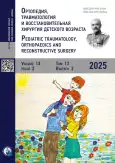Clinical and MRI features of patellar instability in children
- Authors: Lukyanov S.A.1, Zorin V.I.1,2
-
Affiliations:
- H. Turner National Medical Research Center for Сhildren’s Orthopedics and Trauma Surgery
- North-Western State Medical University named after I.I. Mechnikov
- Issue: Vol 13, No 2 (2025)
- Pages: 145-153
- Section: Clinical studies
- URL: https://journal-vniispk.ru/turner/article/view/312533
- DOI: https://doi.org/10.17816/PTORS678328
- EDN: https://elibrary.ru/ESAPBY
- ID: 312533
Cite item
Abstract
BACKGROUND: Patellar instability refers to recurrent dislocations and subluxations of the patella relative to the femoral trochlear groove. This condition is one of the most common disorders of the knee joint in pediatric patients. Both bone and soft tissue structures act as stabilizers of the patella, and alterations in any of these components may contribute to patella instability. Magnetic resonance imaging (MRI) findings related to the osteochondral and soft tissue structures of the patellofemoral joint in children with patellar instability, as well as their correlation with clinical presentation, are of practical interest.
AIM: This study aimed to assess the key MRI features of the patellofemoral joint zone in pediatric patients with patellar instability and evaluate their clinical manifestations.
METHODS: Epidemiological, clinical, and MRI data were analyzed for patients with patellar instability and anterior cruciate ligament injury. The study included 52 patients in the main group and 44 patients in the comparison group with anterior cruciate ligament injury. No statistically significant differences in age distribution were observed.
RESULTS: Significant differences were identified between the groups in terms of Wiberg patellar type, presence of a patellar apprehension sign, and patellar hypermobility. Differences were also noted in the lateral inclination and depth of the trochlear groove, as well as in the frequency of clinical signs such as patellar apprehension and patellar hypermobility (p < 0.001).
CONCLUSION: Trochlear dysplasia is a key predisposing factor for the development of patellar instability in pediatric patients. This study confirmed statistically significant differences in the parameters characterizing trochlear dysplasia, as well as the influence of this factor on patellar instability in children, including its correlation with clinical manifestations.
Full Text
##article.viewOnOriginalSite##About the authors
Sergey A. Lukyanov
H. Turner National Medical Research Center for Сhildren’s Orthopedics and Trauma Surgery
Author for correspondence.
Email: Sergey.lukyanov95@yandex.ru
ORCID iD: 0000-0002-8278-7032
SPIN-code: 3684-5167
MD, PhD, Cand. Sci. (Medicine)
Russian Federation, Saint PetersburgVyacheslav I. Zorin
H. Turner National Medical Research Center for Сhildren’s Orthopedics and Trauma Surgery; North-Western State Medical University named after I.I. Mechnikov
Email: zoringlu@yandex.ru
ORCID iD: 0000-0002-9712-5509
SPIN-code: 4651-8232
MD, PhD, Cand. Sci. (Medicine), Assistant Professor
Russian Federation, Saint Petersburg; Saint PetersburgReferences
- Adachi N. Diagnosis and treatment of patellar instability. Orthop J Sports Med. 2024;12(10_suppl3):2325967124S00382. doi: 10.1177/2325967124S00382 EDN: MFPYIA
- Poorman MJ, Talwar D, Sanjuan J, et al. Increasing hospital admissions for patellar instability: a national database study from 2004 to 2017. Phys Sportsmed. 2020;48(2):215–221. doi: 10.1080/00913847.2019.1680088
- Fithian DC, Paxton EW, Stone ML, et al. Epidemiology and natural history of acute patellar dislocation. Am J Sports Med. 2004;32(5):1114–1121. doi: 10.1177/0363546503260788
- Colvin AC, West RV. Patellar instability. J Bone Joint Surg Am. 2008;90(12):2751–2762. doi: 10.2106/JBJS.H.00211
- Jayne C, Mavrommatis S, Shah AD, et al. Risk factors and treatment rationale for patellofemoral instability in the pediatric population. J Pediatr Orthop Soc North Am. 2024;6:100015. doi: 10.1016/j.jposna.2024.100015 EDN: GMHSBX
- Kapur S, Wissman RD, Robertson M, et al. Acute knee dislocation: review of an elusive entity. Curr Probl Diagn Radiol. 2009;38(6):237–250. doi: 10.1067/j.cpradiol.2008.06.001
- Buchner M, Baudendistel B, Sabo D, Schmitt H. Acute traumatic primary patellar dislocation: long-term results comparing conservative and surgical treatment. Clin J Sport Med. 2005;15(2):62–66. doi: 10.1097/01.jsm.0000157315.10756.14
- Meyers AB, Laor T, Sharafinski M, Zbojniewicz AM. Imaging assessment of patellar instability and its treatment in children and adolescents. Pediatr Radiol. 2016;46(5):618–636. doi: 10.1007/s00247-015-3520-8 EDN: YTKAFJ
- Pooley RA. Fundamental Physics of MR Imaging. RadioGraphics. 2005;25(4):1087–1099. doi: 10.1148/rg.254055027
- Association of Traumatologists-Orthopedists of Russia. Clinical guidelines “Patellar dislocation (adults, children)”. Ministry of Health of Russia, 2024. Available from: https://cr.minzdrav.gov.ru/view-cr/657_2 (In Russ.)
- Nacey NC, Geeslin MG, Miller GW, Pierce JL. Magnetic resonance imaging of the knee: An overview and update of conventional and state of the art imaging. Magn Reson Imaging. 2017;45(5):1257–1275. doi: 10.1002/jmri.25620
- Carrillon Y, Abidi H, Dejour D, et al. Patellar instability: assessment on MR images by measuring the lateral trochlear inclination-initial experience. Radiology. 2000;216(2):582–585. doi: 10.1148/radiology.216.2.r00au07582
- Diederichs G, Issever AS, Scheffler S. MR imaging of patellar instability: injury patterns and assessment of risk factors. RadioGraphics. 2010;30(4):961–981. doi: 10.1148/rg.304095755
- Pfirrmann CWA, Zanetti M, Romero J, Hodler J. Femoral trochlear dysplasia: MR findings. Radiology. 2000;216(3):858–864. doi: 10.1148/radiology.216.3.r00se38858
- Wilcox JJ, Snow BJ, Aoki SK, et al. Does landmark selection affect the reliability of tibial tubercle-trochlear groove measurements using MRI? Clin Orthop Relat Res. 2012;470(8):2253–2260. doi: 10.1007/s11999-012-2269-8
- Charles MD, Haloman S, Chen L, et al. Magnetic resonance imaging-based topographical differences between control and recurrent patellofemoral instability patients. Am J Sports Med. 2013;41(2):374–384. doi: 10.1177/0363546512472441
- Joseph SM, Cheng C, Solomito MJ, Pace JL. Patellar height: comparison of measurement techniques and correlation with other pathoanatomic measures of patellar instability. Orthop J Sports Med. 2019;7(3_suppl):2325967119S00176. doi: 10.1177/2325967119S00176
- Trasolini NA, Serino J, Dandu N, Yanke AB. Treatment of proximal trochlear dysplasia in the setting of patellar instability: an arthroscopic technique. Arthrosc Tech. 2021;10(10):e2253–e2258. doi: 10.1016/j.eats.2021.05.027 EDN: RTJKWN
- Djuricic G, Milanovic F, Ducic S, et al. Morphometric parameters and mri morphological changes of the knee and patella in physically active adolescents. Medicina. 2023;59(2):213. doi: 10.3390/medicina59020213 EDN: NEFFUA
- Steensen RN, Bentley JC, Trinh TQ, et al. The prevalence and combined prevalences of anatomic factors associated with recurrent patellar dislocation: a magnetic resonance imaging study. Am J Sports Med. 2015;43(4):921–927. doi: 10.1177/0363546514563904
- Joseph SM, Cheng C, Solomito MJ, Pace JL. Lateral trochlear inclination angle: measurement via a 2-image technique to reliably characterize and quantify trochlear dysplasia. Orthop J Sports Med. 2020;8(10):2325967120958415. doi: 10.1177/2325967120958415 EDN: UMSZKS
- Paiva M, Blønd L, Hölmich P, et al. Quality assessment of radiological measurements of trochlear dysplasia; a literature review. Knee Surg Sports Traumatol Arthrosc. 2018;26(3):746–755. doi: 10.1007/s00167-017-4520-z EDN: WXSYJR
Supplementary files











